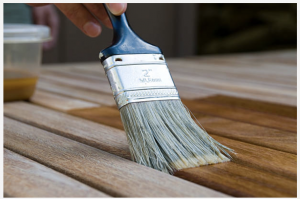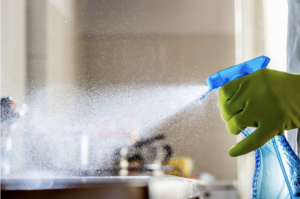Author: Gualtieri Huguenin Clara Emmanuelle

In order to contextualize Semi Volatile Organic Compounds (SVOCs), lets first talk about where they are situated in the broad range of indoor air pollutants. There are three main categories; inorganic gases (including CO2, O3, CO, H2S), organic gases where one finds Volatile Organic Compounds (VOCs), the broader family of SVOCs and finally, Particulate Matter, that can either be organic or inorganic, found under solid or liquid form in the air. SVOCs are part of the organic gases family and are the most well-known family of VOCs, their size range can vary from few nanometers to few micrometers and they can be inhaled from the air or digested from food. The difference between VOCs and SVOCs lies in their tendency to evaporate. In fact, the “semi-volatility” characteristic of SVOCs makes them less likely to evaporate and more prone to condense and stick onto surfaces. Once they are adsorbed on different surfaces such as walls, carpets, furniture or dust, they can remain there for extended periods of time and be re-emitted in the environment at different emission rates which are difficult to predict due to the large different available surfaces. Because of this random exposure pattern, the precise human exposition to those polluant is difficult to quantify. In addition, it will be less easier to remove SVOCs in the air compared to VOCs or VVOCs (Very Volatile Organic Compounds) by simply using a higher air exchange rate as they are slowly re-emitted over long periods of time in the air. However, it has been found that a large part of the SVOCs present in houses are found in dust, thus, measuring the concentration of SVOCs in dust samples is how nowadays exposure is estimated.
” Lack of data on concentrations of SVOCs in consummer goods still represents the biggest obstacle in linking the sources of chemicals to chemicals in air and dust“
Indoor source



What is the commun points of those three images ?
They may actually all emit SVOCs ! Gas cooking is a combustion process releasing hydrocarbons that are part of the SVOCs family, in the second image surface coatings can contain some Polychlorinated biphenyls (PCBs) which are compounds that were widely used in buildings for filling materials, joints, cable coatings, paints and flame retardants, and represent a broad family of SVOCs. Finally (third image) cleaning products can also be a source of perfluoroalkyl substances (PFAs) that are part of SVOCs chemicals. However it is still difficult to know the concentration of those SVOCs in products because it is not mandatory to mention their presence.
Human health effects
The reason why SVOCs are becoming a main concern is that methods to estimate the exposure to those pollutant are limited while it has been proven that they endanger human health causing asthma, endocrine disruption problem related (flame retardant) and some are even carcinogenic (PAHs). The problem is that, because of the wide range of SVOCs coumpouds as well as size and partitioning phase between gas and particule, efforts toward prevention are complicated and different compouds are rather assesed separtely when it comes to link them to a particular health risk. For example PCBs, which can be found into some pesticides can persist into the food chain mainly in meat and fish due to their stability inside the adipose tissues rather than in plants.
Future trends
One major problem is that data concentration of SVOCs in consumer goods is lacking and this prevents from linking these chemical’s sources with indoor air or dust concentrations. A study that collected and reviewed 256 papers about the link between SVOCs containing products and air / dust concentrations presented the below table (partially reproduced) showing the clear gap of information about coumpounds in different consummer products.
| Class of chemicals | Carpet, textiles | Electronics | Furniture | Building materials/ flooring | Cleaning products | Health/Personal care product |
| EBRFs | ||||||
| PFASs | ||||||
| PCBs | ||||||
| PAHs | ||||||
| Pesticides | ||||||
| synthetic musks | ||||||
| Chlorinated paraffins | ||||||
| Parabens |
Table 1: Application of SVOCs in consummer products. In green the availability of concentration values, in yellow availability of information of SVOCs in the consummer product with no concentration. White cells indicate no information of the SVOCs in consummer product.
The goal of the study was to be able to identify the main gap in this field and the study concluded that concentration of SVOCs in consummer products is the biggest obstacle toward reasearch on indoor SVOCs human exposure: “The identification of the main sources of specific indoor contaminant was not possible because most of the cases only presence was reported, but no concentration were given.” Therefore in the coming years, further research is needed to better understand the sources and emission pathways of SVOCs in indoor environments as well as strengthen policy regulation toward public awarness of SVOCs concentration in consummer products. Some complex model, due to the fact that they have to take into account different behaviour of SVOCs such as deposition, resuspension and partitioning, have been developped to predict SVOCs fraction in dust but future research may focus on improving them.
Mitigation strategies
In the meantime, one can mitigate indoor SVOCs exposure by choosing low-SVOCs products or SVOCs-free alternatives for cleaning products. However, low emitting products can remain a significant source of SVOC emission even if the source has been removed, especially if there are many furnitures in the room or wall coverings, because those chemicals have the capacity to adsorb on other materials. The following website; HomeFree offers a ranking for product from green to red in order to help making aware decisions for building occupants and workers. A good and frequent ventilation is also required in the case the indoor space has many new furnitures that may off-gassing into the air at room temperatures. Finally as dust may be more found around electrical equipment due to electrostatical forces, some SVOCs such as flame retardant have been found in higher concentration in dust over equiment than in dust aound. Therefore removing dust everywhere even around cables where it accumulates removes some SVOCs coumpouds that could be re-emitted slowly in the air and one should never neglect a good removal of dust in their home.
References
Papers:
Role of dust loading in dynamic transport of semi-volatile organic compounds (SVOCs) into house dust: From multilayer to monolayer, Jianping Cao, Yuqing Zhu, Xinyi Huang, Li Zhang, Xuanhao Wang, Chuang Geng, Haibao Huang, April 2023, https://doi.org/10.1016/j.buildenv.2023.110084.
Distribution Patterns of Brominated, Chlorinated, and Phosphorus Flame Retardants with Particle Size in Indoor and Outdoor Dust and Implications for Human Exposure, Zhiguo Cao, Fuchao Xu, Adrian Covaci, Min Wu, Haizhu Wang, Gang Yu, Bin Wang, Shubo Deng, Jun Huang, and Xiaoyan Wang, July 2014, https://doi.org/10.1021/es501224b
Estimating indoor semi-volatile organic compounds (SVOCs) associated with settled dust by an integrated kinetic model accounting for aerosol dynamics, Shanshan Shi and Zhao Bin, April 2015
Surface Emissions Modulate Indoor {SVOC} Concentrations through Volatility-Dependent Partitioning,Juin 2020, https://doi.org/10.1021/acs.est.0c00966
Consulted websites:
https://resources.wellcertified.com/articles/emerging-research-on-svocs-and-indoor-air-quality/
https://silentspring.org/our-science/how-are-we-exposed-toxic-chemicals
https://healthybuilding.net/blog/509-the-next-challenge-in-indoor-air-quality-svocs